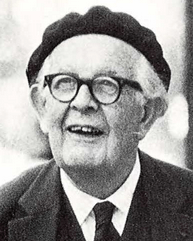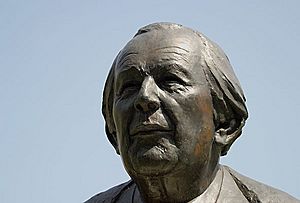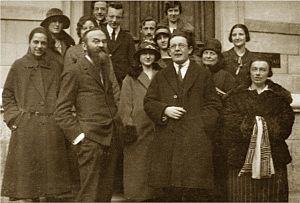Jean Piaget facts for kids
Quick facts for kids
Jean Piaget
|
|
|---|---|

Piaget at the University of Michigan, c. 1968
|
|
| Born |
Jean William Fritz Piaget
9 August 1896 Neuchâtel, Switzerland
|
| Died | 16 September 1980 (aged 84) Geneva, Switzerland
|
| Alma mater | University of Neuchâtel University of Zürich |
| Known for | Constructivism, Genevan School, genetic epistemology, theory of cognitive development, object permanence, egocentrism |
| Scientific career | |
| Fields | Developmental psychology, epistemology |
| Influences |
|
| Influenced |
|
Jean Piaget (born August 9, 1896 – died September 16, 1980) was a Swiss psychologist. He is famous for his important work on how children grow and learn. His ideas about how our thinking develops are called "cognitive development." He also created a field called "genetic epistemology," which looks at how knowledge grows over time.
Piaget believed that education was super important for children. He once said that "only education is capable of saving our societies from possible collapse." Many teachers still use his ideas today to help students learn in active, hands-on ways. In 1955, Piaget started a special center in Geneva to study how knowledge develops. He led this center until he passed away in 1980.
His ideas became very popular in the 1960s. This helped make the study of child development a big part of psychology. By the end of the 1900s, Piaget was one of the most mentioned psychologists ever.
Contents
About Jean Piaget's Life
Piaget was born in 1896 in Neuchâtel, Switzerland. He was the oldest child of a professor and came from a family with interesting roots. Even when he was young, Piaget loved biology and the natural world. By the time he was 15, he had already published several articles about snails and other mollusks!
One time, when he was 15, his old nanny apologized for lying about a fake kidnapping when he was a baby. Piaget was amazed that he still remembered this event, even after he knew it wasn't true. This made him curious about how memories work.
He became interested in how we gain knowledge, called epistemology, because his godfather encouraged him to study philosophy. He went to the University of Neuchâtel and briefly to the University of Zürich.
After college, Piaget moved to Paris. He worked at a school run by Alfred Binet, who created an early intelligence test. While helping to score these tests, Piaget noticed something interesting. Young children often made the same kinds of mistakes, but older children and adults didn't. This made him think that young children's brains work differently from adults' brains. He later suggested that people go through different stages of thinking as they grow up.
In 1921, Piaget went back to Switzerland and became the director of the Rousseau Institute in Geneva. He married Valentine Châtenay in 1923, and they had three children. Piaget studied his own children closely to learn about their development. From 1925 to 1929, he was a professor at the University of Neuchâtel. He also led the International Bureau of Education for many years, where he shared his ideas about teaching.
In 1979, Piaget won a special award called the Balzan Prize for his work in social and political sciences. He passed away on September 16, 1980, and was buried in Geneva.
How Jean Piaget Studied Thinking

Jean Piaget's work on how people think and learn can be seen in different parts. Here are some of the main ways he looked at development:
- Social Development: He first thought about how children move from thinking only about themselves (egocentrism) to understanding others' viewpoints (sociocentrism). He would ask children questions and then follow up based on their answers. He noticed that children's ideas changed as they interacted with others.
- Biological Development: Piaget believed that thinking grows like a living thing adapts to its environment. He used two main ideas:
- Assimilation: This is when you use what you already know to understand something new. For example, a baby might try to suck on every new toy, because sucking is what they know how to do.
- Accommodation: This is when you change your ideas or learn new ways to deal with something new. A baby might learn to pick up a toy with their hand before putting it in their mouth.
- Logical Thinking: Piaget also looked at how our ability to think logically develops in stages as we get older. He thought that each stage builds on the one before it.
- Figurative Thinking: He studied how we use things like perception (what we see) and memory (what we remember). These are not always perfectly logical. For example, a picture cannot be "un-pictured" back to its parts.
Piaget thought that children should learn things when they are ready for them. For example, very young children might not understand that if you pour water from a tall glass into a wide glass, it's still the same amount of water. They need to reach a certain stage of thinking to understand this.
Piaget's Theory of Cognitive Development
Piaget saw himself as a "genetic epistemologist." This means he was interested in how our knowledge develops over time, especially how children's thinking changes. He believed that our thinking structures grow like biological systems.
He studied his own three children very carefully, watching and understanding how their thinking developed. He also wrote about how we balance new information with what we already know. This process, called "equilibration," uses assimilation and accommodation.
Piaget believed that to understand how we know things, we need to look at how knowledge develops from childhood.
The Four Stages of Thinking
Piaget's theory describes four main stages of how children's thinking develops:
- 1. Sensorimotor Stage (Birth to about 2 years old):
* Babies learn about the world through their senses (seeing, hearing, touching) and by moving their bodies. * They are very focused on themselves and can't easily understand things from other people's viewpoints. * A key idea here is object permanence. This means understanding that something still exists even if you can't see it (like when you hide a toy under a blanket). * Babies start with simple reflexes, then learn to repeat actions that feel good (like sucking their thumb). * Later, they start doing things on purpose, like shaking a rattle to make noise. They also begin to explore new ways to use objects.
- 2. Preoperational Stage (About 2 to 7 years old):
* Children start to learn to speak and use symbols, like words or drawings, to represent things. * They love to play pretend (like using a box as a table). * However, they still have trouble with "concrete logic." This means they can't easily think about things in reverse or understand that something can have more than one feature at once. * They are still pretty egocentric, meaning they find it hard to see things from someone else's point of view. * They ask "why?" and "how come?" a lot because they want to know everything!
- 3. Concrete Operational Stage (About 7 to 11 years old):
* Children can now think more logically, especially about things they can see or touch. * They understand reversibility (that actions can be undone, like adding and subtracting). * They also understand conservation (that the amount of something stays the same even if its shape changes). * They are less egocentric and can understand other people's perspectives better. * They get much better at sorting and classifying things.
- 4. Formal Operational Stage (About 11 to 16 years old and older):
* Teens start to develop abstract reasoning. This means they can think about ideas that aren't physical, like justice or freedom. * They can solve problems in their minds, think about possibilities, and plan multiple steps ahead. * They can also think about their own thinking, which is called metacognition.
How Thinking Develops
Piaget believed that development is a cycle. Children do something, see what happens, and then learn from it. By trying things many times, they start to understand how things work. They also learn about objects by seeing how their actions affect them.
This helps children build new levels of knowledge. Once they learn something new, they use it to do even more complex things. This process is like an upward spiral, where each new stage builds on the last one.
For example, a young child might learn to recognize different animals. Then, they learn to group them into categories like "birds" or "fish." Once they know something is a bird, they can guess it might lay eggs.
How Piaget Did His Research
Piaget wanted to change how research was done. He started with traditional methods but then tried new ways, combining observing children naturally, using tests, and doing interviews. He wanted to understand not just what children answered, but how they thought to get to that answer.
In one study, he asked boys aged 10 to 14 to describe flowers. He wanted to see how they reasoned. He also tried to understand children's conversations when adults weren't around.
Challenges in Research
Piaget found it hard to truly understand children's deepest thoughts. It was tough to know if a child was really believing something or just pretending. For example, if a child talks to a toy, do they really think the toy is alive?
He realized that how he asked questions could change a child's answers. He learned to tell the difference between answers that were just "freed" (said because they were asked) and those that were "spontaneous" (what the child truly thought).
Criticism of Piaget's Methods
Some people today think Piaget's research methods had problems. For example, he often studied only a few children, sometimes just his own three kids! This makes it hard to say if his findings apply to all children.
Also, he worked closely with the children and didn't always follow the exact same steps for everyone. This could make the results less consistent. Since he didn't have voice recorders, he just wrote notes by hand, which he then analyzed himself. Today, researchers use multiple people to check the data.
Critics also say that Piaget's tests might have been too hard for children to understand the language or the social situation. This could have made it seem like children couldn't do certain things when they actually could. When other scientists tried to repeat Piaget's experiments with small changes, they sometimes got different results. This suggests that the way the test was done really mattered.
Piaget's Big Impact
Even though some of his ideas have been updated, Piaget's influence is still huge. There's even a special group called the Jean Piaget Society that holds conferences every year! His theory of cognitive development has affected many areas:
- Developmental Psychology: He is seen as the most important person in this field. Even though some of his specific findings have changed, he created the path for others to follow.
- Education: Piaget's ideas changed how teachers think about learning. He helped create a more "child-centered" approach. This means teachers focus on students as active learners who build their own understanding. They try to provide hands-on experiences and support children's natural curiosity.
* For example, in the concrete operational stage, children can think about steps in a task and focus on different parts at once. This helps them with schoolwork like vocabulary lists or math problems. * Piaget believed that knowledge is built by doing things and thinking about them. So, learning happens best when students are actively involved. * However, some experts argue that Piaget's ideas have sometimes been misunderstood in education. For instance, just giving children objects to play with in math isn't enough; they also need clear teaching from adults.
- Morality: Piaget thought that children develop ideas about right and wrong in stages. He believed that children create their own moral views, often from interacting with other kids, not just from what adults tell them. He said that fairness and justice come from equal relationships with friends, where everyone can share their ideas.
- Artificial Intelligence (AI): Piaget's work even influenced computer science! Ideas from his theories were used to create programming languages and early computer systems that helped develop the graphical user interfaces we use today.
Major Achievements
Appointments
- 1921–25 Research Director, Institut Jean-Jacques Rousseau, Geneva
- 1925–29 Professor of Psychology, Sociology and Philosophy of Science, University of Neuchâtel
- 1929–67 Director, International Bureau of Education, Geneva
- 1932–71 Director, Institute of Educational Sciences, University of Geneva
- 1955–80 Director, International Centre for Genetic Epistemology, Geneva
- 1971–80 Emeritus Professor, University of Geneva
Honorary Doctorates
Piaget received many honorary degrees from famous universities around the world, including:
- 1936 Harvard
- 1946 Sorbonne
- 1953 Chicago
- 1954 McGill
- 1959 Manchester
- 1960 Cambridge
- 1970 Yale
Important Books by Jean Piaget
Here are some of his most famous books:
- The Language and Thought of the Child (1926)
- The Child's Conception of the World (1928)
- The Moral Judgment of the Child (1932)
- The Origins of Intelligence in Children (1952)
- Play, Dreams and Imitation in Childhood (1962)
- The Psychology of Intelligence (1950)
- The Construction of Reality in the Child (1954)
- With Inhelder, B., The Growth of Logical Thinking from Childhood to Adolescence (1958)
- With Inhelder, B., The Psychology of the Child (1962)
- Genetic Epistemology (1971)
Images for kids
See also
 In Spanish: Jean Piaget para niños
In Spanish: Jean Piaget para niños






